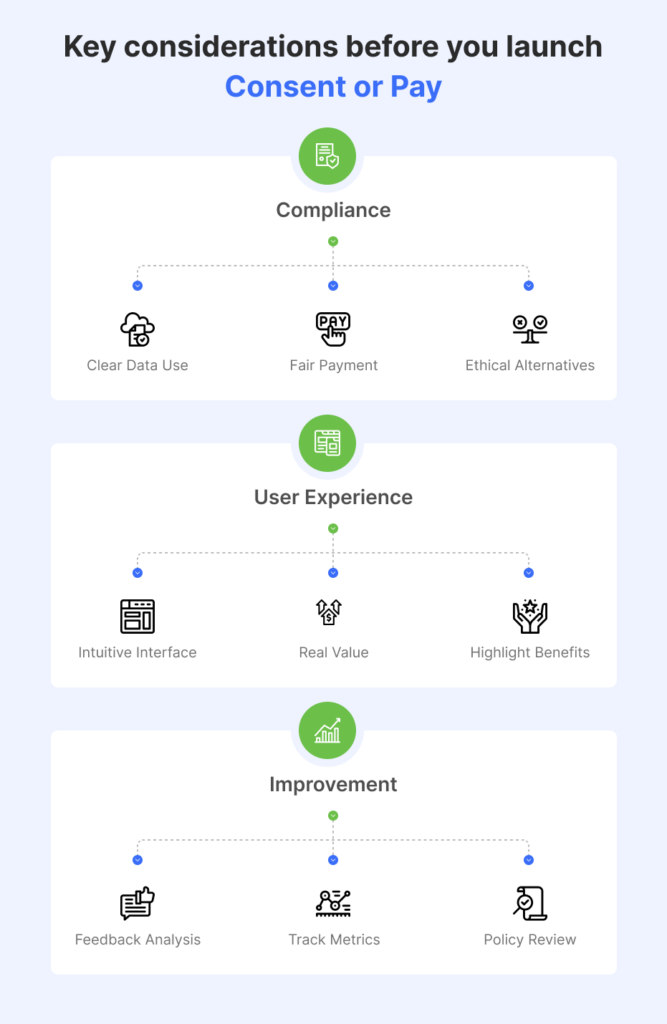What would you choose: share your personal data for personalised ads or pay a monthly fee to browse in peace? This is the uncomfortable question users now face with the rise of “Consent or Pay” models.
As tech giants like Meta introduce subscription-based access in exchange for data privacy, the very foundation of digital consent is being challenged. Is privacy becoming a luxury good? Or are businesses finally giving users more control?
This blog will cover what “Consent or Pay” really means, how it fits within GDPR and ePrivacy laws, and what businesses and users must know. We’ll explore regulatory opinions, ethical dilemmas, monetisation strategies, and best practices for staying compliant while respecting user choice.
The “Consent or Pay” model gives users a binary choice: either consent to data tracking, usually for personalised advertising, or pay a subscription fee for an ad-free experience. It has been popularised by major platforms like Meta, which began testing this approach in Europe in response to mounting regulatory scrutiny.
Meta’s subscription-based version of Instagram and Facebook in the EU costs around €9.99/month. It reflects the growing trend of monetising user privacy directly. This model attempts to align with GDPR consent requirements by offering an alternative to cookie tracking.
The “Consent or Pay” model is becoming a cornerstone of modern privacy and monetisation strategies. It’s driven by several interconnected factors that reflect both compliance needs and market evolution:
This dual path—subscription vs data tracking—offers a practical yet controversial way to satisfy user consent requirements while sustaining business models. Platforms see it as a viable, if temporary, solution to balance compliance with monetisation.
The European Data Protection Board (EDPB) issued an opinion in April 2024 stating that this model may not offer users a genuine choice, especially if the alternative (payment) is not proportionate. According to GDPR consent requirements, consent must be freely given, specific, informed, and unambiguous.
When access to a service is conditioned on consent to data processing or payment, the EDPB warns that it could amount to coercion. Especially if there are no reasonable alternatives, such models may render consent invalid under GDPR.
The UK Information Commissioner’s Office (ICO) has acknowledged that the “Consent or Pay” model is not inherently unlawful. However, it emphasises that consent must be genuinely optional. ICO consent guidance states users must clearly understand choices without facing unfair consequences.
Businesses must carefully assess whether the payment option is reasonable and whether users have real freedom of choice.
As digital regulations tighten, businesses must rethink how they balance privacy and profitability. “Consent or Pay” introduces a compelling solution—one that merges legal compliance with user choice and operational sustainability:
This approach supports businesses in adapting to data privacy compliance tools while maintaining competitive engagement.
Despite the potential, implementing “Consent or Pay” is not without serious risks. Here are some of the potential challenges:
Companies should consider data privacy compliance tools to ensure smooth implementation.
| Benefits | Challenges |
|---|---|
| Consent-based monetisation | Legal compliance risks |
| Builds user trust | Potential user drop-off |
| Supports GDPR compliance | Complex backend management |
| Diversifies revenue streams | Regulatory scrutiny risk |
| Appeals to privacy-conscious | Higher operational costs |
| Enables transparent choices | Ethical concerns over access |
One of the key criticisms of “Consent or Pay” is its potential to exclude users who cannot afford the subscription. This raises ethical concerns around digital equity. Are we creating a two-tier internet where privacy is only for those who can pay?
These paywall consent models risk widening the digital divide and limiting access to essential content and services.
True informed consent hinges on transparency. Users must be informed about what data is collected, how it’s used, and what the payment alternative entails. Without clarity, there’s a risk of manipulative consent practices.
A user-friendly interface, supported by a strong consent management platform, is key to making this work ethically.

Transparency and fairness form the foundation for effective and lawful consent mechanisms. To achieve this:
Together, these actions build trust and ensure compliance with GDPR and ICO guidance.
Clear and simple user interfaces empower users to make informed, pressure-free choices. This means:
By focusing on usability, businesses improve satisfaction and customer experience.
Ongoing evaluation is essential to adapting and maintaining compliant consent systems. Key steps include:
Regular refinement fosters resilience and sustains user trust in evolving conditions.
Regulators are actively monitoring the rollout of these models. Expect tighter controls and clearer definitions in upcoming EU guidelines. Enforcement of GDPR consent requirements will likely increase, with penalties for models deemed coercive.
Privacy-enhancing tools are gaining traction, offering cookie consent alternatives like contextual targeting and differential privacy. AI is also streamlining compliance processes by automating consent tracking and user preference management.
There is a growing demand for privacy-first digital experiences. Subscription models and privacy solutions are becoming more common, especially in media and content platforms. However, the market may also shift toward hybrid models that don’t rely solely on consent or payment.
Businesses that anticipate these shifts will be better positioned to offer ethical, scalable alternatives to cookie tracking.
“Consent or Pay” reflects a growing effort to align user choice with business models in today’s privacy-conscious world. But it’s not the only path. Many users increasingly expect privacy to be a basic right, not something they have to pay for. Businesses that offer strong data protection with free access can appeal to this expectation, earning user trust and loyalty.
With smart consent tools and ethical design, companies can meet compliance standards while positioning themselves as privacy-forward leaders in the market. The opportunity lies in showing that protecting privacy doesn’t need to come with a price tag.
Get started with Seers, an AI-powered consent management platform, designed for full GDPR and CCPA compliance. Flexible pricing plans start from just £8/month. Empower trust and grow confidently.
Start Free Today“Consent or Pay” gives users two options: accept data tracking (usually for targeted ads) or pay a subscription fee to use a service without tracking. It’s a monetisation method aimed at aligning with GDPR consent rules while preserving business revenue.
It is not outright illegal, but legality depends on implementation. The EDPB says it may breach GDPR if users are forced into a choice that isn’t fair, informed, or freely given. The model must pass strict tests of necessity, proportionality, and user autonomy.
Fairness depends on whether users have a genuine, unpressured choice, whether the payment amount is proportionate, and whether free alternatives exist. The model must not exploit economic inequality or coerce consent, as required by GDPR’s standard of freely given, informed, and specific consent.
Possibly. The European Data Protection Board (EDPB) stated in 2024 that such models could violate GDPR if users feel compelled to consent due to high costs or lack of alternatives. If consent is not freely given, the model risks being declared unlawful under GDPR.
While it offers businesses a path to monetise legally, it risks shifting privacy from a right to a paid service. If misapplied, it can distort user choice and lead to compliance issues, weakening the balance between profit and the protection of personal data.
Adoption may be limited. With strong GDPR enforcement and growing political and legal scrutiny, the model could face regulatory setbacks. Success depends on how fairly it’s implemented and whether it respects both the spirit and letter of privacy law.
 Rimsha Zafar
Rimsha ZafarRimsha is a Senior Content Writer at Seers AI with over 5 years of experience in advanced technologies and AI-driven tools. Her expertise as a research analyst shapes clear, thoughtful insights into responsible data use, trust, and future-facing technologies.


United Kingdom
24 Holborn Viaduct
London, EC1A 2BN
Get our monthly newsletter with insightful blogs and industry news
By clicking “Subcribe” I agree Terms and Conditions

Seers Group © 2025 All Rights Reserved
Terms of use | Privacy policy | Cookie Policy | Sitemap | Do Not Sell or Share My Personal Information.